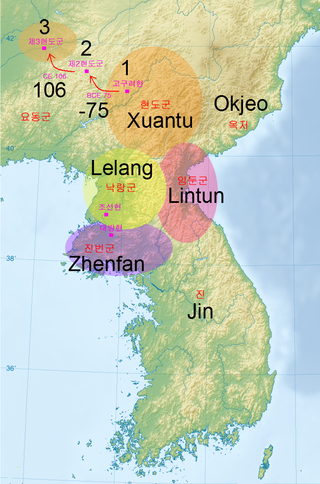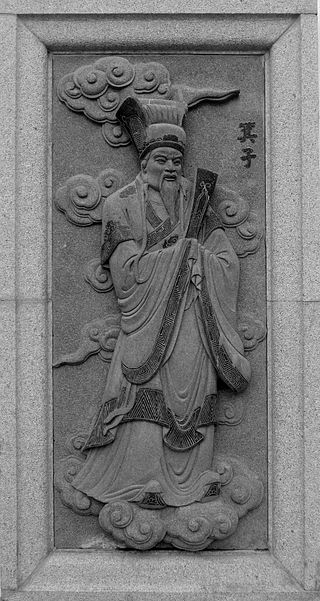
The Lelang Commandery was a commandery of the Han dynasty established after it had conquered Wiman Joseon in 108 BC and lasted until Goguryeo conquered it in 313. The Lelang Commandery extended the rule of the Four Commanderies of Han as far south as the Han River in present-day South Korea. South Korean scholars have described its administrative areas as being limited to the Pyongan and Hwanghae regions, whose southern bounds lie roughly 75 miles north of the Han River.

A mausoleum is an external free-standing building constructed as a monument enclosing the burial chamber of a deceased person or people. A mausoleum without the person's remains is called a cenotaph. A mausoleum may be considered a type of tomb, or the tomb may be considered to be within the mausoleum.

Jizi, Qizi, or Kizi was a semi-legendary Chinese sage who is said to have ruled Gija Joseon in the 11th century BCE. Early Chinese documents like the Book of Documents and the Bamboo Annals described him as a virtuous relative of the last king of the Shang dynasty who was punished for remonstrating with the king. After Shang was overthrown by Zhou in the 1040s BCE, he allegedly gave political advice to King Wu, the first Zhou king. Chinese texts from the Han dynasty onwards claimed that King Wu enfeoffed Jizi as ruler of Chaoxian. According to the Book of Han, Jizi brought agriculture, sericulture, and many other facets of Chinese civilization to Joseon. His family name was Zi/Ja (子) and given name was Xuyu/Suyu.

Dangun or Tangun, also known as Dangun Wanggeom, was the legendary founder and first king of Gojoseon, the first Korean kingdom. He founded the first kingdom around the northern part of the Korean Peninsula. He is said to be the "grandson of heaven", "son of a bear", and to have founded the first kingdom in 2333 BC. The earliest recorded version of the Dangun legend appears in the 13th-century Samguk yusa, which cites Korea's lost historical record, Gogi and China's Book of Wei.

Baekje or Paekche was a Korean kingdom located in southwestern Korea from 18 BCE to 660 CE. It was one of the Three Kingdoms of Korea, together with Goguryeo and Silla. While the three kingdoms were in separate existence, Baekje had the highest population of approximately 3,800,000 people, which was much larger than that of Silla and similar to that of Goguryeo.

Gojoseon, contemporary name Joseon, was the first kingdom on the Korean Peninsula. According to Korean mythology, the kingdom was established by the legendary king Dangun. Gojoseon possessed the most advanced culture in the Korean Peninsula at the time and was an important marker in the progression towards the more centralized states of later periods. The addition of Go, meaning "ancient", is used in historiography to distinguish the kingdom from the Joseon dynasty, founded in 1392 CE.

Wiman Joseon was a dynasty of Gojoseon. It began with Wiman's seizure of the throne from Gija Joseon's King Jun and ended with the death of King Ugeo who was a grandson of Wiman. Apart from archaeological data, the main source on this historical period comes from chapter 115 of Sima Qian's Records of the Grand Historian. Wiman was originally a Chinese military leader from the Kingdom of Yan under the Han dynasty.

Goguryeo tombs, officially designated as the Complex of Koguryo Tombs, are tombs in North Korea. In July 2004, they became the first UNESCO World Heritage site in the country. The site consists of 30 individual tombs from the later Goguryeo kingdom, one of Three Kingdoms of Korea, located in the cities of P'yŏngyang and Namp'o. Goguryeo was one of the strongest ancient Korean kingdoms located in the northern and central parts of the Korean Peninsula and the southern and central parts of Manchuria. The kingdom was founded in the present day area of North Korea, and part of Manchuria around 37 BCE, and the capital was transferred to P'yŏngyang in 427 CE.

Gaecheonjeol is a public holiday in South Korea on 3 October. Also known by the English name National Foundation Day, this holiday celebrates the legendary formation of the first Korean state of Gojoseon by legendary king Dangun in 2333 BC. This date has traditionally been regarded by Koreans as the date for the founding of the Korean race.

The Proto–Three Kingdoms period refers to the proto-historical period in the Korean Peninsula, after the fall of Gojoseon and before the maturation of Goguryeo, Baekje, and Silla into full-fledged kingdoms. It is a subdivision of what is traditionally called Korea's Three Kingdoms period and covers the first three centuries of the Common Era, corresponding to the later phase of the Korean Iron Age.

Kwansŏ (Korean: 관서), or Gwanseo, is a region of Korea. It lies in the northwest of the Korean Peninsula, occupied by the North Korean provinces of North Pyongan, South Pyongan, and Chagang, as well as the cities of Pyongyang and Nampo.
Hwandan Gogi, also called Handan Gogi, is a pseudohistorical compilation of texts on ancient Korean history. It is a bound volume of four supposedly historical records.
The three Gojoseon kingdoms are states thought to have existed according to Joseon Sangosa (1924–25). The concept gained a following among several fringe historians, although it is not completely accepted by mainstream scholars.

The Tomb of the General, is an ancient Korean pyramid, also known as the Pyramid of the East. The pyramid is thought to be the burial tomb of King Gwanggaeto or his son King Jangsu, both former Kings of Goguryeo.

The Four Commanderies of Han were Chinese commanderies located in the north of the Korean Peninsula and part of the Liaodong Peninsula from around the end of the second century BC through the early 4th AD, for the longest lasting. The commanderies were set up to control the populace in the former areas of Gojoseon as far south as the Han River, with a core area at Lelang near present-day Pyongyang by Emperor Wu of the Han dynasty in early 2nd century BC after his conquest of Wiman Joseon. As such, these commanderies are seen as Chinese colonies by some scholars. Though disputed by North Korean scholars, Western sources generally describe the Lelang Commandery as existing within the Korean peninsula, and extend the rule of the four commanderies as far south as the Han River. However, South Korean scholars assumed its administrative areas to Pyongan and Hwanghae provinces.

The Capital Cities and Tombs of the Ancient Koguryo Kingdom is an UNESCO World Heritage Site which includes a number of archaeological sites currently in Ji'an, Jilin Province and Huanren, Liaoning Province in Northeast China. Goguryeo, was a Korean Kingdom located in the northern and central parts of the Korean Peninsula and the southern and central parts of Manchuria.

The Tomb of King Dongmyeong, also known as the Tomb of King Tongmyŏng, is a mausoleum located in near Ryongsan Village, Ryokpo-guyok, Pyongyang, North Korea. One of the tombs is the royal tomb of Jumong, the founder of the ancient Goguryeo Kingdom, the northernmost of the Three Kingdoms of Korea. King Jumong was given the posthumous name of King Dongmyeong. In total, there are 63 individual tombs of the period. The area around Dongmyeong's grave contains at least fifteen known tombs believed to belong to various vassal lords. The tomb has achieved World Heritage status as part of the Complex of Goguryeo Tombs inscribed by UNESCO in 2004 under Criteria (i), (ii), (iii) and (iv) covering an area of 233 hectares with a buffer zone of 1,701 hectares. A unique feature of it and the other extant tombs in the area are the wall paintings depicting blossoming lotuses, indicative of Buddhism practiced and perhaps prevalent in Korea around 277 BC to 668 AD.

Jizi (Gija) allegedly fled the Chinese Shang dynasty to the Korean Peninsula, where he founded the dynastic state of Gija Joseon and eventually succeeded Dangun as king of Gojoseon. Legend says that Gija brought to the Korean people many skills from China, such as agriculture and weaving; he is also credited with founding the city of Pyongyang.

Korean nationalist historiography is a way of writing Korean history that centers on the Korean minjok, an ethnically defined Korean nation. This kind of nationalist historiography emerged in the early twentieth century among Korean intellectuals who wanted to foster national consciousness to achieve Korean independence from Japanese domination. Its first proponent was journalist and independence activist Shin Chaeho (1880–1936). In his polemical New Reading of History, which was published in 1908 three years after Korea became a Japanese protectorate, Shin proclaimed that Korean history was the history of the Korean minjok, a distinct race descended from the god Dangun that had once controlled not only the Korean peninsula but also large parts of Manchuria. Nationalist historians made expansive claims to the territory of these ancient Korean kingdoms, by which the present state of the minjok was to be judged.















